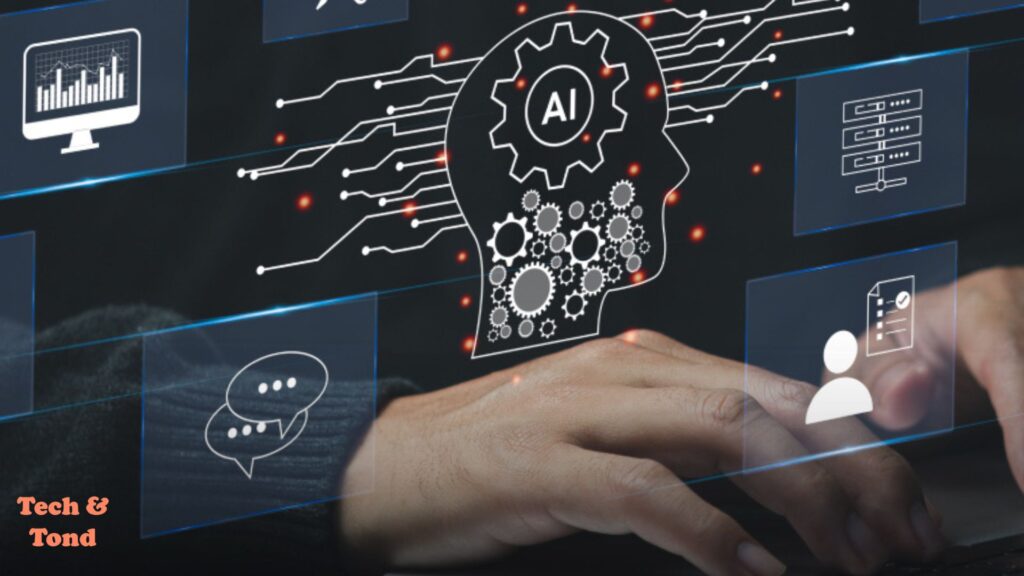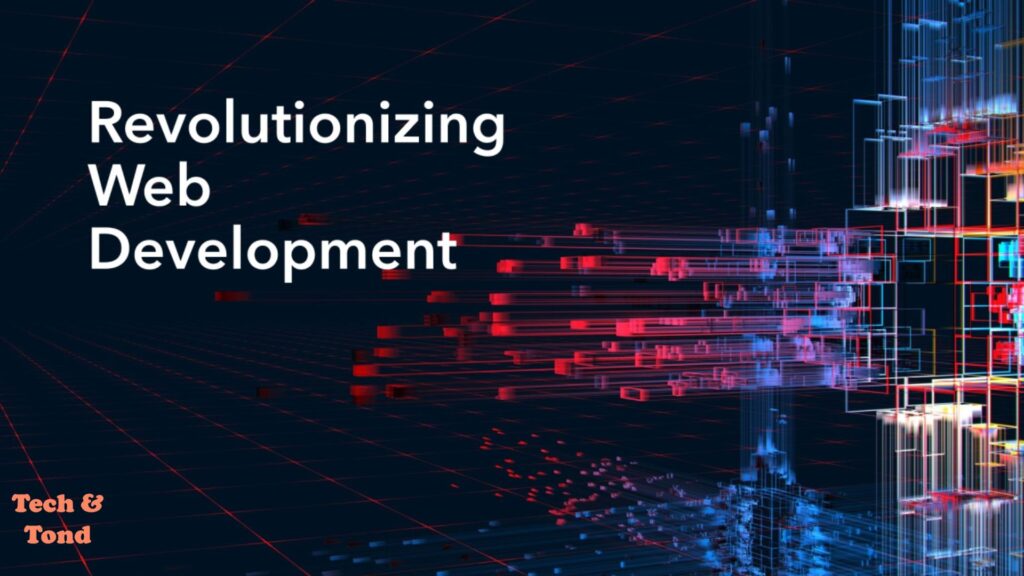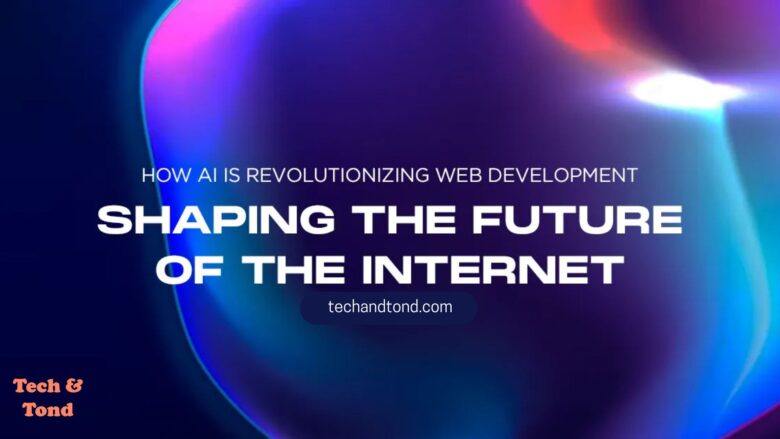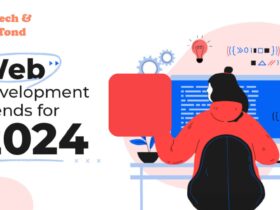Discover how AI is transforming modern web development with advanced tools, personalized user experiences, and innovative technologies like no-code platforms, AR/VR integration, and real-time data analysis. Explore the future of intelligent, user-centric websites.
Web development has evolved dramatically over the years, transitioning from basic static pages to dynamic, user-centric platforms. Today, Artificial Intelligence (AI) stands at the forefront of this evolution, reshaping how developers design, build, and optimize websites. AI brings a new level of efficiency, personalization, and functionality to web development, enabling groundbreaking innovations that were once deemed impossible.
Understanding Artificial Intelligence and Its Role in Web Development
What is Artificial Intelligence?
Artificial Intelligence (AI) is the branch of computer science focused on developing systems that can replicate human cognitive abilities. These abilities include tasks like problem-solving, logical reasoning, learning from experience, understanding natural language, recognizing patterns, and making decisions. In web development, AI plays a pivotal role by enabling features such as personalized content recommendations, advanced chatbots for customer support, predictive analytics to forecast user behavior, and automated testing to ensure site functionality. AI-driven tools also assist in optimizing search engine results, improving website accessibility, and enhancing cybersecurity by identifying and mitigating potential threats.
How AI Enhances Technology
In web development, AI is not merely an add-on; it serves as a driving force for innovation. Here are a few critical roles AI plays:
- Automation: Minimizes repetitive tasks like coding or debugging.
- Personalization: Delivers tailored content based on user preferences and behavior.
- Efficiency: Speeds up development timelines while improving accuracy.
Applications of AI in Web Development
1. AI-Powered Chatbots
Instant and Seamless Customer Support
AI-powered chatbots have redefined customer service by delivering instant, 24/7 assistance. Utilizing Natural Language Processing (NLP), these intelligent bots can interpret and respond to user queries in a natural, conversational manner. This not only reduces response times but also ensures users receive accurate and context-aware information, significantly improving customer satisfaction.
Tailored Assistance Beyond FAQs
Unlike traditional chatbots limited to answering pre-set questions, AI-driven chatbots offer personalized support tailored to individual needs. They assist users in navigating websites, recommending products, or resolving specific issues in real time. For example, an AI chatbot on an e-commerce platform can guide customers through the purchase process, answering queries like, “What’s the best laptop for graphic design?” while considering the user’s budget and preferences.
Enhanced Engagement Across Industries
AI chatbots are not confined to e-commerce; they’re widely employed in sectors like healthcare for scheduling appointments, finance for providing account details, and travel for booking assistance. By integrating user behavior insights, these bots continuously improve their recommendations and interactions, fostering deeper engagement and building brand loyalty.
Scalability and Cost-Effectiveness
Businesses benefit from AI chatbots by significantly reducing operational costs while scaling customer support to handle large volumes of inquiries. This enables organizations to focus human resources on more complex tasks, ensuring a balanced and efficient customer service strategy.
2.AI in Web Design: Transforming the Creative Process
Streamlining Design with AI-Driven Tools
Artificial Intelligence is revolutionizing the way websites are designed by automating intricate tasks and enhancing creative workflows. Tools like Wix ADI (Artificial Design Intelligence) and Adobe Sensei empower designers and developers to create stunning websites efficiently. These platforms offer advanced capabilities, such as:
- Automated Layout Generation: AI tools can craft entire website layouts based on minimal user input, saving time and effort while maintaining a professional aesthetic.
- Smart Design Recommendations: They analyze the content and purpose of a website to suggest suitable fonts, color palettes, and design elements, ensuring a cohesive visual identity.
- Responsive Design Optimization: AI ensures websites are fully responsive, adapting seamlessly to different screen sizes and devices for a superior user experience.
Enhancing Accessibility for Inclusive Design
AI technology plays a vital role in making web designs more inclusive, ensuring that websites are accessible to all users, regardless of their abilities. Key contributions include:
- Identifying Accessibility Gaps: AI tools can scan websites to detect issues like missing alt text, poor color contrast, or non-compliant navigation structures.
- Automating Fixes: These tools provide solutions to address accessibility challenges, such as adjusting color schemes for better visibility or creating screen-reader-friendly content.
- Real-Time Monitoring: AI ensures ongoing compliance with accessibility standards, such as WCAG (Web Content Accessibility Guidelines), to keep websites user-friendly for diverse audiences.
Personalization and User-Centric Design
AI enhances web design by personalizing user experiences. It analyzes user behavior and preferences to tailor website layouts, content, and navigation. For example:
- Dynamic Content Delivery: AI adjusts homepage designs or featured products based on user interests.
- Behavioral Insights: Designers can leverage AI analytics to understand how users interact with a website and refine the design accordingly.
Empowering Designers and Businesses
With AI handling repetitive tasks and optimizing designs, web designers can focus on creativity and strategy. Businesses benefit from faster project completion, reduced costs, and websites that are both visually appealing and highly functional. AI not only democratizes web design by making advanced tools accessible to non-experts but also sets new standards for quality and efficiency in the digital landscape.
3. Content Management with AI
Streamlined Content Creation
AI tools like Jasper and Grammarly aid writers by suggesting ideas, improving readability, and even generating high-quality content based on predefined keywords.
SEO Optimization
AI analyzes search trends, evaluates keyword density, and refines meta descriptions to help websites rank higher on search engines. Tools like Yoast SEO and SEMrush integrate AI to optimize on-page elements efficiently.

AI in Front-End Development: Pioneering User-Centric Innovations
1. Dynamic and Adaptive Interfaces
AI is redefining front-end development by enabling the creation of intuitive and adaptive user interfaces (UI) that respond intelligently to user behavior. Through advanced data analytics, AI examines user interactions, such as click patterns, scrolling behavior, and time spent on different sections of a page. This analysis empowers developers to refine layouts, making interfaces more user-friendly and efficient.
For example:
- Interactive Navigation: AI-powered systems can adjust navigation menus to prioritize frequently used features.
- Content Prioritization: Based on user preferences, AI can dynamically reorder content, ensuring the most relevant information appears first.
- Behavioral Heatmaps: AI generates visual representations of user engagement, helping developers identify underperforming elements and optimize them.
This adaptability leads to interfaces that evolve alongside user needs, delivering a more seamless and satisfying experience.
2. Real-Time Personalization
AI has revolutionized the concept of personalization in front-end development by enabling real-time content customization. Platforms like Netflix, Spotify, and Amazon leverage AI to analyze vast amounts of user data, such as viewing history, listening preferences, and purchase behavior. This data drives the delivery of tailored recommendations and personalized experiences, ensuring users feel valued and understood.
Key implementations include:
- Dynamic Content Recommendations: AI suggests movies, music, or products based on real-time user activity, enhancing engagement.
- Localized Experiences: AI adapts content based on a user’s location, language, and cultural preferences, fostering a deeper connection.
- Predictive Personalization: By identifying trends in user behavior, AI anticipates future needs, offering suggestions before the user actively searches for them.
For example, Netflix uses AI algorithms to recommend shows or movies based on a viewer’s past selections, while Spotify curates custom playlists like “Discover Weekly” by analyzing listening habits.
3. Enhanced User Engagement and Retention
AI’s ability to deliver highly relevant, context-aware experiences not only engages users but also builds long-term loyalty. By understanding individual preferences and anticipating needs, AI fosters a sense of connection between the user and the platform.
4. Automation in Front-End Workflow
AI assists developers in streamlining their workflows by automating repetitive tasks, such as:
- Code Generation: AI tools can write boilerplate code, reducing development time.
- UI Testing: Automated testing tools powered by AI can identify bugs, ensure responsiveness, and improve overall functionality.
- Real-Time Feedback: AI systems provide insights on design effectiveness and usability during the development phase, minimizing post-launch revisions.
5. Bridging Accessibility and Aesthetics
AI ensures that adaptive interfaces remain visually appealing while being accessible to users with diverse needs. It achieves this by automatically suggesting design modifications, such as color contrast adjustments or alternative navigation methods, without compromising aesthetic appeal.
Machine Learning and Web Development: Unlocking Intelligent Solutions
1. Advanced Data Analysis
Machine Learning (ML) has revolutionized the way web applications process and interpret vast amounts of data. ML algorithms are designed to uncover intricate patterns, trends, and insights from complex datasets, enabling developers to create smarter, more responsive applications.
Key applications include:
- Predicting User Needs: ML analyzes browsing history, search queries, and user behavior to anticipate what users are likely to look for next. For instance, an e-commerce platform can predict the next purchase a customer might make based on their browsing patterns and prior purchases.
- Optimizing Content Delivery: ML identifies the type of content users engage with most, allowing websites to prioritize and deliver relevant content for a tailored experience.
- Behavioral Insights: By continuously analyzing how users interact with a website, ML provides developers with actionable insights to refine the site’s design and functionality.
For example, ML-powered analytics tools can help a blog site understand which topics resonate most with readers, enabling better content planning and audience targeting.
2. Intelligent Recommendation Systems
Recommendation engines powered by ML have become a cornerstone of successful web applications, especially in e-commerce, streaming platforms, and content delivery systems. These engines use algorithms to analyze user behavior, preferences, and interactions to suggest products, services, or content.
Real-world examples include:
- E-Commerce Platforms: Retail websites like Amazon use ML for their “Customers who bought this also bought” feature, showcasing complementary products and boosting cross-selling opportunities.
- Streaming Services: Platforms like Netflix and Spotify recommend movies, shows, or playlists tailored to a user’s viewing or listening history, enhancing engagement and retention.
- Educational Platforms: Websites like Coursera or Khan Academy suggest courses or learning materials based on a user’s progress and interests.
How Recommendation Systems Work
Recommendation engines typically operate on one or more of these approaches:
- Collaborative Filtering: Suggesting items based on similarities between users with similar preferences.
- Content-Based Filtering: Recommending items similar to what a user has already engaged with.
- Hybrid Models: Combining multiple techniques for more accurate and personalized recommendations.
3. Automation in Web Processes
Machine Learning also enhances web development by automating complex processes, allowing developers to focus on more strategic tasks. For instance:
- Dynamic Pricing: ML adjusts prices in real-time based on demand, competition, and customer behavior.
- Fraud Detection: ML identifies unusual activity patterns to protect users from fraud in real-time.
- Chatbots: Integrated with ML, chatbots improve their responses over time by learning from user interactions, offering more accurate and helpful support.
4. Enhancing User Experience with Predictive Analytics
Predictive analytics powered by ML helps websites deliver proactive experiences. For example:
- Travel Websites: Predict flight price fluctuations to recommend the best booking times.
- Retail Sites: Forecast trends and stock inventory accordingly to meet demand without overstocking.
5. Continuous Learning for Better Performance
Unlike static systems, ML models learn and evolve over time. As they process more data, their predictions and recommendations become increasingly accurate, ensuring web applications remain adaptive to changing user preferences and behaviors.
Advanced AI Applications in Technology and Web Development
1. AI-Generated Code: Revolutionizing Software Development
Artificial Intelligence is transforming the coding process by enabling tools that can understand and generate code based on developer input. Platforms like GitHub Copilot use AI models, such as OpenAI’s Codex, to assist developers by generating code snippets, completing functions, and even writing entire sections of code.
Key Benefits:
- Time Efficiency: AI-powered tools significantly reduce the time spent on repetitive coding tasks by auto-suggesting solutions tailored to the developer’s requirements.
- Error Reduction: By suggesting well-tested, optimized code, AI minimizes the likelihood of bugs and logical errors, enhancing overall code quality.
- Learning and Productivity: Developers, especially beginners, can learn new techniques or best practices from AI suggestions, fostering continuous improvement.
Examples in Action:
- Code Completion: AI tools predict the next lines of code, streamlining the writing process. For instance, when building a function, the tool might suggest parameter structures, loops, or error-handling mechanisms.
- Debugging Assistance: AI identifies errors and recommends fixes in real time, reducing debugging time and improving efficiency.
- Multi-Language Support: Developers can rely on AI to quickly adapt code across different programming languages, ensuring versatility and compatibility.
These tools are becoming indispensable for developers, helping them focus on complex logic while automating mundane tasks.
2. Voice Interfaces and Enhanced Search Functionality
With the proliferation of voice-activated devices like Amazon Alexa, Google Assistant, and Apple’s Siri, integrating voice interfaces into websites has become increasingly important. AI is at the forefront of this trend, enhancing search accuracy and user accessibility through voice recognition technologies.
Core Advantages:
- Hands-Free Navigation: Voice-enabled interfaces allow users to interact with websites without the need for a keyboard or mouse, improving accessibility for users with disabilities or those in hands-busy situations.
- Improved Search Precision: AI-powered voice search interprets natural language queries, making it easier for users to find relevant information. Unlike traditional keyword-based searches, AI understands context, synonyms, and conversational tones.
- Global Reach: Voice AI supports multiple languages and accents, enabling websites to cater to a diverse audience.
Real-World Applications:
- E-Commerce Websites: Users can search for products by saying phrases like, “Show me laptops under $1,000,” or “Find a gift for a 10-year-old.”
- Customer Support: Voice assistants integrated into websites guide users through troubleshooting steps or direct them to relevant resources.
- Healthcare Portals: Patients can use voice search to book appointments, access medical records, or ask health-related questions.
3. The Intersection of AI and User Experience
Voice interfaces are not just about convenience; they enhance user experience by making interactions more intuitive and human-like. AI systems learn from user queries over time, refining their accuracy and improving the overall quality of interactions.
Challenges of Implementing AI in Web Development
While AI offers transformative potential for web development, its implementation comes with significant challenges that developers and businesses must navigate. These obstacles range from financial constraints to ethical dilemmas and skill-related issues. Addressing these challenges is crucial to harnessing AI’s full potential.
1. High Initial Costs
One of the most significant barriers to integrating AI in web development is the substantial initial investment required. This includes:
- Infrastructure Costs: Setting up AI systems often requires powerful hardware, such as high-performance servers and GPUs, which can be expensive.
- Software Tools: Licensing or subscribing to advanced AI tools and platforms like TensorFlow, AWS AI, or Azure AI incurs recurring costs.
- Data Acquisition: Collecting, cleaning, and maintaining large datasets for training AI models is resource-intensive.
- Training and Development: Organizations must invest in training employees or hiring AI specialists, further adding to the expense.
Although these costs are substantial, the long-term benefits—such as automation, improved efficiency, and enhanced user experiences—often justify the investment. However, small and medium-sized enterprises (SMEs) may find it particularly challenging to bear these upfront expenses without external funding or gradual adoption strategies.
2. Ethical Concerns
The ethical implications of AI in web development cannot be overlooked. If not carefully managed, AI systems can perpetuate or even amplify biases present in their training data, leading to discriminatory outcomes. For example:
- Bias in Recommendations: An AI-powered recommendation system might favor certain products, services, or demographics, inadvertently sidelining others.
- Privacy Issues: The extensive data collection required for AI can raise concerns about user privacy and consent.
- Transparency and Accountability: Users and stakeholders may struggle to understand how AI systems make decisions, leading to mistrust.
To address these concerns:
- Diverse Datasets: Developers must ensure that the data used to train AI models represents a wide range of users, avoiding biases tied to race, gender, or socioeconomic status.
- Ethical Guidelines: Establishing clear ethical standards and auditing AI systems regularly can promote fairness and inclusivity.
- User Consent: Providing users with clear information about data usage and obtaining their consent ensures compliance with privacy regulations like GDPR and CCPA.
3. Skill Gap
The rapid evolution of AI technology has created a significant skill gap in the web development industry. Many developers lack the expertise required to effectively implement and manage AI systems. Key challenges include:
- Complexity of AI Tools: Advanced platforms and frameworks, such as PyTorch or OpenCV, often require specialized knowledge.
- Continuous Learning: The fast-paced nature of AI advancements demands that developers stay updated with new techniques and tools.
- Interdisciplinary Knowledge: Implementing AI effectively often requires a blend of skills, including programming, data science, and domain-specific expertise.
Solutions to Bridge the Gap:
- Training Programs: Companies can invest in workshops, bootcamps, and online courses to upskill their development teams.
- Collaborative Learning: Building cross-functional teams that include AI specialists alongside web developers can help share knowledge and expertise.
- Open-Source Resources: Leveraging community-driven platforms and repositories can provide developers with free tools and learning opportunities.

The Future of AI in Web Development
The integration of Artificial Intelligence (AI) into web development is paving the way for groundbreaking advancements that will reshape how websites are created, experienced, and managed. As AI continues to evolve, it is set to enhance accessibility, interactivity, and personalization in unprecedented ways.
1. No-Code and Low-Code Platforms: Democratizing Web Development
AI-powered no-code and low-code platforms, such as Webflow, Bubble, and Wix ADI (Artificial Design Intelligence), are revolutionizing the web development landscape by empowering non-technical users to create sophisticated websites. These platforms leverage AI to automate complex coding tasks, allowing users to focus on creativity and functionality.
Key Features and Benefits:
- Drag-and-Drop Interfaces: Users can visually design websites without writing a single line of code, making web development accessible to entrepreneurs, small businesses, and creatives.
- AI-Powered Assistance: These platforms suggest design elements, layouts, and color schemes tailored to the user’s goals and preferences.
- Rapid Prototyping: AI simplifies the creation of prototypes, enabling faster testing and iteration of ideas.
Future Prospects:
- AI will continue to enhance these platforms by integrating more advanced capabilities, such as automated SEO optimization, dynamic content generation, and multi-platform deployment. This will enable even greater inclusivity in web development.
2. Integration with AR and VR: Crafting Immersive Digital Experiences
AI is poised to be a driving force behind the seamless integration of Augmented Reality (AR) and Virtual Reality (VR) into web development, transforming static websites into interactive and immersive experiences.
Current Applications:
- AR for E-Commerce: Retail websites are using AR to allow customers to visualize products in their real-world environments, such as seeing how furniture would look in their homes.
- VR for Virtual Tours: Real estate and travel websites employ VR to offer users immersive tours of properties or destinations.
AI’s Role in Enhancing AR and VR:
- Content Personalization: AI tailors AR and VR experiences to individual user preferences, ensuring relevant and engaging interactions.
- Enhanced Interactivity: AI enables realistic simulations and responsive environments, improving the overall user experience.
- Streamlined Development: AI tools simplify the creation of AR and VR content by automating rendering, object recognition, and interaction design.
Future Applications:
In the near future, AI-driven AR and VR will be pivotal in fields like education, healthcare, and entertainment, offering highly interactive and engaging web-based solutions.
3. Real-Time Hyper-Personalization: Elevating User Engagement
Personalization has always been a cornerstone of effective web design, and AI is taking it to the next level with real-time hyper-personalization. By analyzing user behavior, preferences, and interactions in real time, AI enables websites to dynamically adapt their content, layout, and functionality for each individual user.
How AI Powers Hyper-Personalization:
- Behavioral Analytics: AI tracks and analyzes data such as browsing patterns, click paths, and session durations to understand user intent.
- Dynamic Content Delivery: Based on user insights, AI delivers personalized content, such as tailored product recommendations, targeted advertisements, or relevant blog posts.
- Adaptive Design: AI adjusts website layouts, navigation, and features to match user preferences, ensuring an optimal experience for everyone.
Future Implications:
- Predictive Personalization: AI will anticipate user needs even before they take action, offering pre-emptive solutions or suggestions.
- Cross-Platform Consistency: Hyper-personalization will extend seamlessly across devices and platforms, maintaining a cohesive user experience.
- Context-Aware Interactions: AI will factor in real-world variables, such as location, time of day, and weather, to deliver highly contextualized experiences.
Conclusion
AI is revolutionizing web development by making it smarter, faster, and more user-centric. From automating repetitive tasks to delivering hyper-personalized experiences, AI empowers developers to push the boundaries of what’s possible. Despite challenges like cost and ethical concerns, the future of AI in web development is incredibly promising, paving the way for innovation and accessibility.
FAQs
1. What are some popular AI tools for web development?
Popular tools include GitHub Copilot for coding, Wix ADI for design, and SEMrush for SEO optimization.
2. How does AI improve website performance?
AI optimizes code, predicts server needs, and provides personalized user experiences, enhancing overall performance.
3. Is AI in web development expensive to implement?
While the initial costs can be high, the efficiency and innovation AI brings often lead to significant long-term savings.
4. What are the ethical challenges of AI in web development?
Bias in AI models and data privacy concerns are significant challenges that require careful consideration and mitigation.
5. How will AI shape the future of web development?
AI will lead to more personalized, accessible, and efficient websites, integrating technologies like AR, VR, and voice interfaces.







Your content shows how AI is changing web development in amazing ways. It explains how tasks are becoming easier and faster with AI tools. A great read for anyone who loves technology.
Thanks a lot for your feedback.